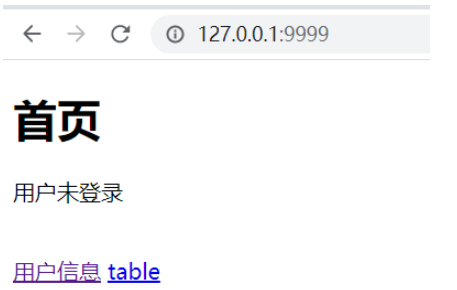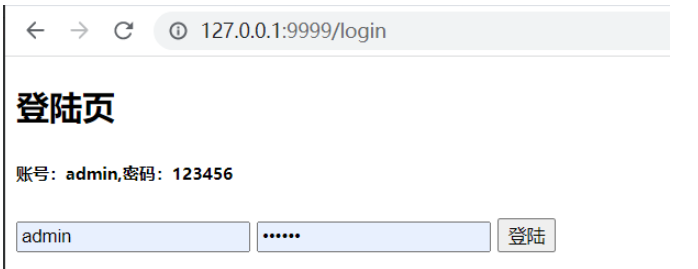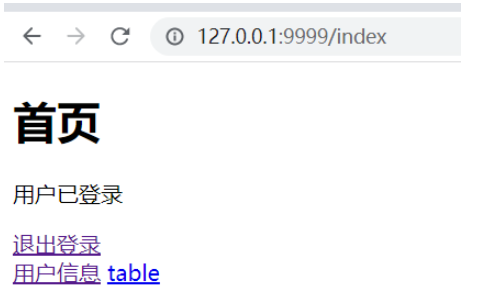Springboot-cli 开发脚手架系列
Springboot优雅的整合Shiro进行登录校验,权限认证(附源码下载)
简介
Springboo配置Shiro进行登录校验,权限认证,附demo演示。
前言
我们致力于让开发者快速搭建基础环境并让应用跑起来,提供使用示例供使用者参考,让初学者快速上手。
本博客项目源码地址:
项目源码github地址
项目源码国内gitee地址
1. 环境
依赖
<!-- Shiro核心框架 -->
<dependency>
<groupId>org.apache.shiro</groupId>
<artifactId>shiro-core</artifactId>
<version>1.9.0</version>
</dependency>
<!-- Shiro使用Spring框架 -->
<dependency>
<groupId>org.apache.shiro</groupId>
<artifactId>shiro-spring</artifactId>
<version>1.9.0</version>
</dependency>
<!-- Thymeleaf中使用Shiro标签 -->
<dependency>
<groupId>com.github.theborakompanioni</groupId>
<artifactId>thymeleaf-extras-shiro</artifactId>
<version>2.1.0</version>
</dependency>
<dependency>
<groupId>org.springframework.boot</groupId>
<artifactId>spring-boot-starter-thymeleaf</artifactId>
</dependency>yml配置
server:
port: 9999
servlet:
session:
# 让Tomcat只能从COOKIE中获取会话信息,这样,当没有Cookie时,URL也就不会被自动添加上 ;jsessionid=… 了。
tracking-modes: COOKIEspring:
thymeleaf:
# 关闭页面缓存,便于开发环境测试
cache: false
# 静态资源路径
prefix: classpath:/templates/
# 网页资源默认.html结尾
mode: HTML
2. 简介
Shiro三大功能模块
Subject
认证主体,通常指用户(把操做交给SecurityManager)。
SecurityManager
安全管理器,安全管理器,管理全部Subject,能够配合内部安全组件(关联Realm)
Realm
域对象,用于进行权限信息的验证,shiro连接数据的桥梁,如我们的登录校验,权限校验就在Realm进行定义。
3. Realm配置
定义用户实体User ,可根据自己的业务自行定义
@Data
@Accessors(chain = true)
public class User {
/**
* 用户id
*/
private Long userId;
/**
* 用户名
*/
private String username;
/**
* 密码
*/
private String password;
/**
* 用户别称
*/
private String name;
}重写AuthorizingRealm 中登录校验doGetAuthenticationInfo及授权doGetAuthorizationInfo方法,编写我们自定义的校验逻辑。
/**
* 自定义登录授权
*
* @author ding
*/
public class UserRealm extends AuthorizingRealm {
/**
* 授权
* 此处权限授予
*/
@Override
protected AuthorizationInfo doGetAuthorizationInfo(PrincipalCollection principalCollection) {
SimpleAuthorizationInfo info = new SimpleAuthorizationInfo();
// 在这里为每一个用户添加vip权限
info.addStringPermission("vip");
return info;
}
/**
* 认证
* 此处实现我们的登录逻辑,如账号密码验证
*/
@Override
protected AuthenticationInfo doGetAuthenticationInfo(AuthenticationToken authenticationToken) throws AuthenticationException {
// 获取到token
UsernamePasswordToken token = (UsernamePasswordToken) authenticationToken;
// 从token中获取到用户名和密码
String username = token.getUsername();
String password = String.valueOf(token.getPassword());
// 为了方便,这里模拟获取用户
User user = this.getUser();
if (!user.getUsername().equals(username)) {
throw new UnknownAccountException("用户不存在");
} else if (!user.getPassword().equals(password)) {
throw new IncorrectCredentialsException("密码错误");
}
// 校验完成后,此处我们把用户信息返回,便于后面我们通过Subject获取用户的登录信息
return new SimpleAuthenticationInfo(user, password, getName());
}
/**
* 此处模拟用户数据
* 实际开发中,换成数据库查询获取即可
*/
private User getUser() {
return new User()
.setName("admin")
.setUserId(1L)
.setUsername("admin")
.setPassword("123456");
}
}4. 核心配置
ShiroConfig.java
/**
* Shiro内置过滤器,能够实现拦截器相关的拦截器
* 经常使用的过滤器:
* anon:无需认证(登陆)能够访问
* authc:必须认证才能够访问
* user:若是使用rememberMe的功能能够直接访问
* perms:该资源必须获得资源权限才能够访问,格式 perms[权限1,权限2]
* role:该资源必须获得角色权限才能够访问
**/
/**
* shiro核心管理器
*
* @author ding
*/
@Configuration
public class ShiroConfig {
/**
* 无需认证就可以访问
*/
private final static String ANON = "anon";
/**
* 必须认证了才能访问
*/
private final static String AUTHC = "authc";
/**
* 拥有对某个资源的权限才能访问
*/
private final static String PERMS = "perms";
/**
* 创建realm,这里返回我们上一把定义的UserRealm
*/
@Bean(name = "userRealm")
public UserRealm userRealm() {
return new UserRealm();
}
/**
* 创建安全管理器
*/
@Bean(name = "securityManager")
public DefaultWebSecurityManager getDefaultWebSecurityManager(@Qualifier("userRealm") UserRealm userRealm) {
DefaultWebSecurityManager securityManager = new DefaultWebSecurityManager();
//绑定realm对象
securityManager.setRealm(userRealm);
return securityManager;
}
/**
* 授权过滤器
*/
@Bean
public ShiroFilterFactoryBean getShiroFilterFactoryBean(@Qualifier("securityManager") DefaultWebSecurityManager defaultWebSecurityManager) {
ShiroFilterFactoryBean bean = new ShiroFilterFactoryBean();
// 设置安全管理器
bean.setSecurityManager(defaultWebSecurityManager);
// 添加shiro的内置过滤器
Map<String, String> filterMap = new LinkedHashMap<>();
filterMap.put("/index", ANON);
filterMap.put("/userInfo", PERMS + "[vip]");
filterMap.put("/table2", AUTHC);
filterMap.put("/table3", PERMS + "[vip2]");
bean.setFilterChainDefinitionMap(filterMap);
// 设置跳转登陆页
bean.setLoginUrl("/login");
// 无权限跳转
bean.setUnauthorizedUrl("/unAuth");
return bean;
}
/**
* Thymeleaf中使用Shiro标签
*/
@Bean
public ShiroDialect shiroDialect() {
return new ShiroDialect();
}
}5. 接口编写
IndexController.java
/**
* @author ding
*/
@Controller
public class IndexController {
@RequestMapping({"/", "/index"})
public String index(Model model) {
model.addAttribute("msg", "hello,shiro");
return "/index";
}
@RequestMapping("/userInfo")
public String table1(Model model) {
return "userInfo";
}
@RequestMapping("/table")
public String table(Model model) {
return "table";
}
@GetMapping("/login")
public String login() {
return "login";
}
@PostMapping(value = "/doLogin")
public String doLogin(@RequestParam("username") String username, @RequestParam("password") String password, Model model) {
//获取当前的用户
Subject subject = SecurityUtils.getSubject();
//用来存放错误信息
String msg = "";
//如果未认证
if (!subject.isAuthenticated()) {
//将用户名和密码封装到shiro中
UsernamePasswordToken token = new UsernamePasswordToken(username, password);
try {
// 执行登陆方法
subject.login(token);
} catch (Exception e) {
e.printStackTrace();
msg = "账号或密码错误";
}
//如果msg为空,说明没有异常,就返回到主页
if (msg.isEmpty()) {
return "redirect:/index";
} else {
model.addAttribute("errorMsg", msg);
return "login";
}
}
return "/login";
}
@GetMapping("/logout")
public String logout() {
SecurityUtils.getSubject().logout();
return "index";
}
@GetMapping("/unAuth")
public String unAuth() {
return "unAuth";
}
}6. 网页资源
在resources中创建templates文件夹存放页面资源
index.html
<!DOCTYPE html>
<html xmlns:th="http://www.thymeleaf.org">
<html xmlns:shiro="http://www.pollix.at/thymeleaf/shiro">
<head>
<meta charset="UTF-8">
<title>Title</title>
</head>
<body>
<h2>首页</h2>
<!-- 使用shiro标签 -->
<shiro:authenticated>
<p>用户已登录</p> <a th:href="@{/logout}" rel="external nofollow" >退出登录</a>
</shiro:authenticated>
<shiro:notAuthenticated>
<p>用户未登录</p>
</shiro:notAuthenticated>
<br/>
<a th:href="@{/userInfo}" rel="external nofollow" >用户信息</a>
<a th:href="@{/table}" rel="external nofollow" >table</a>
</body>
</html>login.html
<!DOCTYPE html>
<html lang="en" xmlns:th="http://www.thymeleaf.org">
<head>
<meta charset="UTF-8">
<title>登陆页</title>
</head>
<body>
<div>
<p th:text="${errorMsg}"></p>
<form action="/doLogin" method="post">
<h3>登陆页</h3>
<h7>账号:admin,密码:123456</h7>
<input type="text" id="username" name="username" placeholder="admin">
<input type="password" id="password" name="password" placeholder="123456">
<button type="submit">登陆</button>
</form>
</div>
</body>
</html>userInfo.html
<!DOCTYPE html>
<html lang="en" xmlns:shiro="http://www.pollix.at/thymeleaf/shiro">
<head>
<meta charset="UTF-8">
<title>table1</title>
</head>
<body>
<h2>用户信息</h2>
<!-- 利用shiro获取用户信息 -->
用户名:<shiro:principal property="username"/>
<br/>
用户完整信息: <shiro:principal/>
</body>
</html>table.hetml
<!DOCTYPE html>
<html lang="en">
<head>
<meta charset="UTF-8">
<title>table</title>
</head>
<body>
<h2>table</h2>
</body>
</html>7. 效果演示
启动项目浏览器输入127.0.0.1:9999

当我们点击用户信息和table时会自动跳转登录页面

登录成功后

获取用户信息
此处获取的就是我们就是我们前面doGetAuthenticationInfo方法返回的用户信息,这里为了演示就全部返回了,实际生产中密码是不能返回的。

以上是Springboot整合Shiro怎么实现登录与权限校验的详细内容。更多信息请关注PHP中文网其他相关文章!
 JVM如何促进Java的'写作一次,在任何地方运行”(WORA)功能?May 02, 2025 am 12:25 AM
JVM如何促进Java的'写作一次,在任何地方运行”(WORA)功能?May 02, 2025 am 12:25 AMJVM通过字节码解释、平台无关的API和动态类加载实现Java的WORA特性:1.字节码被解释为机器码,确保跨平台运行;2.标准API抽象操作系统差异;3.类在运行时动态加载,保证一致性。
 Java的较新版本如何解决平台特定问题?May 02, 2025 am 12:18 AM
Java的较新版本如何解决平台特定问题?May 02, 2025 am 12:18 AMJava的最新版本通过JVM优化、标准库改进和第三方库支持有效解决平台特定问题。1)JVM优化,如Java11的ZGC提升了垃圾回收性能。2)标准库改进,如Java9的模块系统减少平台相关问题。3)第三方库提供平台优化版本,如OpenCV。
 说明JVM执行的字节码验证的过程。May 02, 2025 am 12:18 AM
说明JVM执行的字节码验证的过程。May 02, 2025 am 12:18 AMJVM的字节码验证过程包括四个关键步骤:1)检查类文件格式是否符合规范,2)验证字节码指令的有效性和正确性,3)进行数据流分析确保类型安全,4)平衡验证的彻底性与性能。通过这些步骤,JVM确保只有安全、正确的字节码被执行,从而保护程序的完整性和安全性。
 平台独立性如何简化Java应用程序的部署?May 02, 2025 am 12:15 AM
平台独立性如何简化Java应用程序的部署?May 02, 2025 am 12:15 AMJava'splatFormIndepentEncealLowsApplicationStorunonAnyOperatingsystemwithajvm.1)singleCodeBase:writeandeandcompileonceforallplatforms.2)easileupdates:updatebybytecodeforsimultaneDeployment.3)testOnOneOnePlatForforuluniverSalpeforuluniverSaliver.4444.4444
 Java的平台独立性如何随着时间的流逝而发展?May 02, 2025 am 12:12 AM
Java的平台独立性如何随着时间的流逝而发展?May 02, 2025 am 12:12 AMJava的平台独立性通过JVM、JIT编译、标准化、泛型、lambda表达式和ProjectPanama等技术不断增强。自1990年代以来,Java从基本的JVM演进到高性能的现代JVM,确保了代码在不同平台的一致性和高效性。
 在Java应用程序中缓解平台特定问题的策略是什么?May 01, 2025 am 12:20 AM
在Java应用程序中缓解平台特定问题的策略是什么?May 01, 2025 am 12:20 AMJava如何缓解平台特定的问题?Java通过JVM和标准库来实现平台无关性。1)使用字节码和JVM抽象操作系统差异;2)标准库提供跨平台API,如Paths类处理文件路径,Charset类处理字符编码;3)实际项目中使用配置文件和多平台测试来优化和调试。
 Java的平台独立性与微服务体系结构之间有什么关系?May 01, 2025 am 12:16 AM
Java的平台独立性与微服务体系结构之间有什么关系?May 01, 2025 am 12:16 AMjava'splatformentenceenhancesenhancesmicroservicesharchitecture byferingDeploymentFlexible,一致性,可伸缩性和便携性。1)DeploymentFlexibilityAllowsibilityAllowsOllowsOllowSorlowsOllowsOllowsOllowSeStorunonAnyPlatformwithajvM.2)penterencyCrossServAccAcrossServAcrossServiCessImplifififiesDeevelopmentandeDe
 GRAALVM与Java的平台独立目标有何关系?May 01, 2025 am 12:14 AM
GRAALVM与Java的平台独立目标有何关系?May 01, 2025 am 12:14 AMGraalVM通过三种方式增强了Java的平台独立性:1.跨语言互操作,允许Java与其他语言无缝互操作;2.独立的运行时环境,通过GraalVMNativeImage将Java程序编译成本地可执行文件;3.性能优化,Graal编译器生成高效的机器码,提升Java程序的性能和一致性。


热AI工具

Undresser.AI Undress
人工智能驱动的应用程序,用于创建逼真的裸体照片

AI Clothes Remover
用于从照片中去除衣服的在线人工智能工具。

Undress AI Tool
免费脱衣服图片

Clothoff.io
AI脱衣机

Video Face Swap
使用我们完全免费的人工智能换脸工具轻松在任何视频中换脸!

热门文章

热工具

螳螂BT
Mantis是一个易于部署的基于Web的缺陷跟踪工具,用于帮助产品缺陷跟踪。它需要PHP、MySQL和一个Web服务器。请查看我们的演示和托管服务。

适用于 Eclipse 的 SAP NetWeaver 服务器适配器
将Eclipse与SAP NetWeaver应用服务器集成。

SublimeText3汉化版
中文版,非常好用

MinGW - 适用于 Windows 的极简 GNU
这个项目正在迁移到osdn.net/projects/mingw的过程中,你可以继续在那里关注我们。MinGW:GNU编译器集合(GCC)的本地Windows移植版本,可自由分发的导入库和用于构建本地Windows应用程序的头文件;包括对MSVC运行时的扩展,以支持C99功能。MinGW的所有软件都可以在64位Windows平台上运行。

安全考试浏览器
Safe Exam Browser是一个安全的浏览器环境,用于安全地进行在线考试。该软件将任何计算机变成一个安全的工作站。它控制对任何实用工具的访问,并防止学生使用未经授权的资源。






